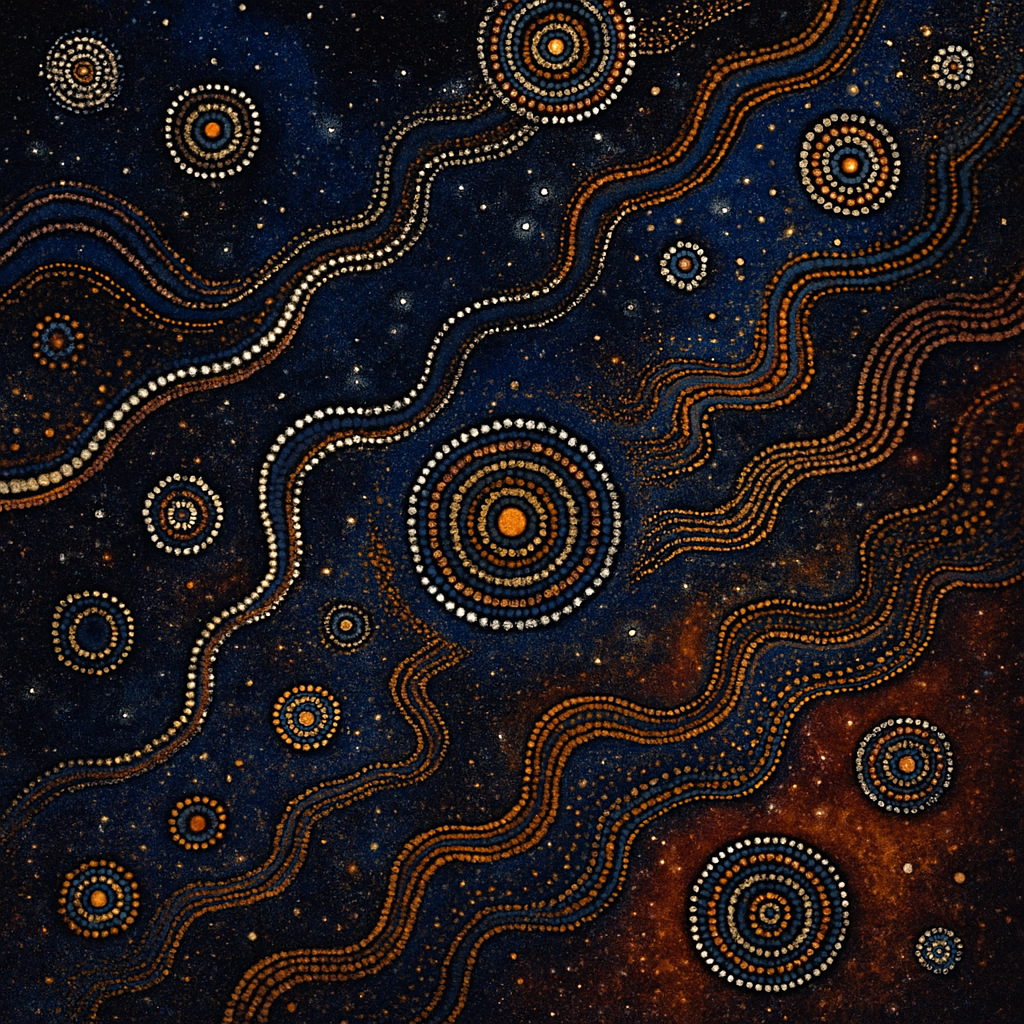Mapping the Invisible Through Symbol and Pattern
Across cultures and continents, Indigenous peoples have developed intricate visual languages not merely to tell stories, but to interact with the world. These are not just artworks—they are field technologies. Within the framework of Emergent Theory, Indigenous art becomes a system for mapping coherence, tracking energetic presence, and maintaining relationship with the seen and unseen.
Aboriginal Dot Paintings: Shimmering Maps of Country
In Australian Aboriginal art, the signature dot technique does more than decorate. It creates a vibrational field—an energetic shimmer that encodes Guruwari, or “seed power,” the idea that every action leaves a metaphysical trace in the land. These works don’t just represent Country; they are Country—alive with ancestral memory and energy patterns that ripple across space.
Symbols like U-shapes for people, concentric circles for waterholes, and line paths for travel or ceremony act as relational markers. Together, they map the resonance of place—showing not only geography, but also spiritual architecture, coherence points, and memory encoded in terrain.
Navajo Sand Paintings: Temporary Fields of Healing
Among the Navajo, sand paintings are created during ceremony and then destroyed—signifying their role not as static art, but as a living interface. These intricate patterns of radiating geometry and sacred symbols call in Holy People and act as energy diagrams for aligning body, spirit, and land.
These mandala-like fields are portals—harmonic spaces built from earth pigments, created to hold spiritual resonance during healing. Like Aboriginal dot works, they embody the principle that form can hold frequency, and that coherence can be summoned through design.
Māori Koru and Kowhaiwhai: Spiral Fields of Life
In Aotearoa (New Zealand), Māori visual systems such as the koru (a spiral based on an unfurling fern) and kowhaiwhai(flowing linear patterns) express growth, ancestry, and cosmic rhythm. These forms are not merely ornamental—they are field glyphs, transmitting ideas about time, emergence, and generational unfolding.
The koru, in particular, depicts spiraling life force—a visual metaphor for the regenerative cycles of nature and lineage. Woven tukutuku panels and carved wharenui (meeting houses) become immersive environments of encoded coherence, where every line and curve is a living narrative.
Huichol Beadwork and Yarn Art: Psychedelic Frequency Maps
In the highlands of Mexico, the Huichol people create vivid yarn paintings and bead mosaics that pulse with symmetrical pattern and symbolic meaning. These artworks depict visions received in trance states, sacred animals, and cosmic cycles—encoded in color, shape, and repetition.
Each image is a portal of frequency, generated through ritual and intention. The beaded surface, like the Aboriginal dot canvas, becomes a matrix of symbolic charge—representing not a static deity or story, but an active vibrational field connected to spirit and cosmos.
Vanuatu Sand Drawings: Movement as Symbolic Transmission
In Vanuatu, the act of drawing complex geometric patterns in sand—known as sandroing—is both artistic and linguistic. These looping designs are made with a single finger in continuous motion, encoding cosmological ideas, clan connections, and ancestral presence.
Like the rarrk shimmer of Arnhem Land or the fluid koru of the Māori, sandroing emphasizes motion as field articulation. The drawing isn’t just the pattern—it is the process, the flow, the resonance left behind. In this way, it maps time and relationship in symbolic flow.
Pattern as Portal: A Unified Field Language
From the Australian desert to the Navajo mesas, the Māori forests to the Huichol mountains, Indigenous art forms share a coherent insight: symbol and pattern are living fields. These are not decorative traditions. They are technologies for reading, navigating, and maintaining coherence with the energetic reality of place, spirit, and ancestry.
What emerges across these practices is a shared recognition that geometry speaks—that it can hold memory, summon presence, and activate healing. Each dot, spiral, line, or bead is part of a larger signal map—a nonverbal language of coherence, consciousness, and relationship.
These are not relics of the past. They are dynamic, living systems—transmitting the wisdom of a world in which the land is conscious, symbols are active, and art is a form of communion with the emergent field.


Leave a Reply